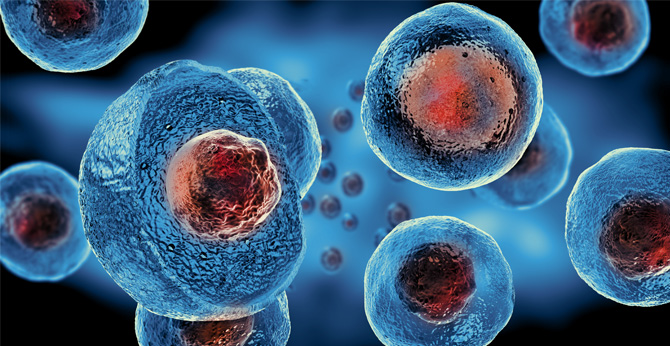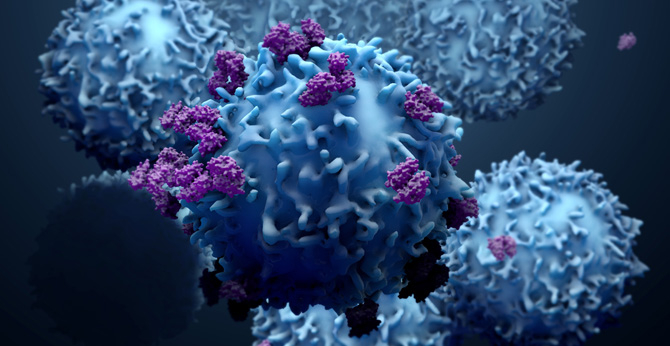All products and services are For Research Use Only and CANNOT be used in the treatment or diagnosis of disease.
This gene encodes a transcription factor that contains four zinc-finger motifs at the C-terminus and a proline/glutamine-rich DNA-binding domain at the N-terminus. It has an essential role in the normal development of the urogenital system, and it is mutated in a small subset of patients with Wilms tumor. This gene exhibits complex tissue-specific and polymorphic imprinting pattern, with biallelic, and monoallelic expression from the maternal and paternal alleles in different tissues. Multiple transcript variants have been described. In several variants, there is evidence for the use of a non-AUG (CUG) translation initiation codon upstream of, and in-frame with the first AUG. Authors of PMID:7926762 also provide evidence that WT1 mRNA undergoes RNA editing in human and rat, and that this process is tissue-restricted and developmentally regulated.
 Loading...
Loading...
| CAT | Product Name | Target Species | Antibody Clone | Antibody Host | Receptor Construction | Vector Type | Targeting Cell Type | CAR Vector Type | Inquiry & Datasheet |
| CAR-ZP8586 | Anti-WT1 (Aali) h(CD28-CD3ζ) CAR, pCDCAR1 | Human | Aali | Human | scFv-CD28-CD3ζ | Lentiviral vector | T cell | ||
| CAR-ZP8587 | Anti-WT1 (Aali) h(4-1BB-CD3ζ) CAR, pCDCAR1 | Human | Aali | Human | scFv-4-1BB-CD3ζ | Lentiviral vector | T cell | ||
| CAR-ZP8588 | Anti-WT1 (DS3886AB) h(CD28-CD3ζ) CAR, pCDCAR1 | Human | DS3886AB | Rabbit | scFv-CD28-CD3ζ | Lentiviral vector | T cell | ||
| CAR-ZP8589 | Anti-WT1 (DS3886AB) h(4-1BB-CD3ζ) CAR, pCDCAR1 | Human | DS3886AB | Rabbit | scFv-4-1BB-CD3ζ | Lentiviral vector | T cell | ||
| CAR-ZP8590 | Anti-WT1 (7G-H3) h(CD28-CD3ζ) CAR, pCDCAR1 | Human | 7G-H3 | Mouse | scFv-CD28-CD3ζ | Lentiviral vector | T cell | ||
| CAR-ZP8591 | Anti-WT1 (7G-H3) h(4-1BB-CD3ζ) CAR, pCDCAR1 | Human | 7G-H3 | Mouse | scFv-4-1BB-CD3ζ | Lentiviral vector | T cell | ||
| CAR-ZP8592 | Anti-WT1 (IHC685) h(CD28-CD3ζ) CAR, pCDCAR1 | Human | IHC685 | Mouse | scFv-CD28-CD3ζ | Lentiviral vector | T cell | ||
| CAR-ZP8593 | Anti-WT1 (IHC685) h(4-1BB-CD3ζ) CAR, pCDCAR1 | Human | IHC685 | Mouse | scFv-4-1BB-CD3ζ | Lentiviral vector | T cell | ||
| CAR-ZP8594 | Anti-WT1 (D8I7F) h(CD28-CD3ζ) CAR, pCDCAR1 | Human | D8I7F | Rabbit | scFv-CD28-CD3ζ | Lentiviral vector | T cell | ||
| CAR-ZP8595 | Anti-WT1 (D8I7F) h(4-1BB-CD3ζ) CAR, pCDCAR1 | Human | D8I7F | Rabbit | scFv-4-1BB-CD3ζ | Lentiviral vector | T cell | ||
| CAR-ZP8596 | Anti-WT1 (1E2) h(CD28-CD3ζ) CAR, pCDCAR1 | Human | 1E2 | Mouse | scFv-CD28-CD3ζ | Lentiviral vector | T cell | ||
| CAR-ZP8597 | Anti-WT1 (1E2) h(4-1BB-CD3ζ) CAR, pCDCAR1 | Human | 1E2 | Mouse | scFv-4-1BB-CD3ζ | Lentiviral vector | T cell | ||
| CAR-ZP8598 | Anti-WT1 (6F-H2) h(CD28-CD3ζ) CAR, pCDCAR1 | Human | 6F-H2 | Mouse | scFv-CD28-CD3ζ | Lentiviral vector | T cell | ||
| CAR-ZP8599 | Anti-WT1 (6F-H2) h(4-1BB-CD3ζ) CAR, pCDCAR1 | Human | 6F-H2 | Mouse | scFv-4-1BB-CD3ζ | Lentiviral vector | T cell | ||
| CAR-ZP8600 | Anti-WT1 (WT1/857) h(CD28-CD3ζ) CAR, pCDCAR1 | Human | WT1/857 | Mouse | scFv-CD28-CD3ζ | Lentiviral vector | T cell | ||
| CAR-ZP8601 | Anti-WT1 (WT1/857) h(4-1BB-CD3ζ) CAR, pCDCAR1 | Human | WT1/857 | Mouse | scFv-4-1BB-CD3ζ | Lentiviral vector | T cell | ||
| XS-0622-ZP3312 | Anti-WT1 h(VHH1-VHH2-CD28-CD3ζ) Biepitopic CAR, pCDCAR1 | Human | VHH1-VHH2-CD28-CD3ζ | Lentiviral vector | T Cell | ||||
| XS-0622-ZP3484 | Anti-WT1 h(VHH1-VHH2-4-1BB-CD3ζ) Biepitopic CAR, pCDCAR1 | VHH1-VHH2-4-1BB-CD3ζ | Lentiviral vector | T Cell | |||||
| XS-0822-YF914 | Anti-Human WT1 (XW-914) h(41BB-CD3ζ) CAR IVT Plasmid, pCARIVT | Human | XW-914 | Mouse | scFv-41BB-CD3ζ | In Vitro Transcription (IVT) Vector | |||
| XS-0822-YF1834 | Anti-Human WT1 (XW-914) h(CD28-CD3ζ) CAR IVT Plasmid, pCARIVT | Human | XW-914 | Mouse | scFv-CD28-CD3ζ | In Vitro Transcription (IVT) Vector |
 NEWSLETTER
NEWSLETTER
The latest newsletter to introduce the latest breaking information, our site updates, field and other scientific news, important events, and insights from industry leaders
LEARN MORE NEWSLETTER NEW SOLUTION
NEW SOLUTION
CellRapeutics™ In Vivo Cell Engineering: One-stop in vivo T/B/NK cell and macrophage engineering services covering vectors construction to function verification.
LEARN MORE SOLUTION NOVEL TECHNOLOGY
NOVEL TECHNOLOGY
Silence™ CAR-T Cell: A novel platform to enhance CAR-T cell immunotherapy by combining RNAi technology to suppress genes that may impede CAR functionality.
LEARN MORE NOVEL TECHNOLOGY NEW SOLUTION
NEW SOLUTION
Canine CAR-T Therapy Development: From early target discovery, CAR design and construction, cell culture, and transfection, to in vitro and in vivo function validation.
LEARN MORE SOLUTION

